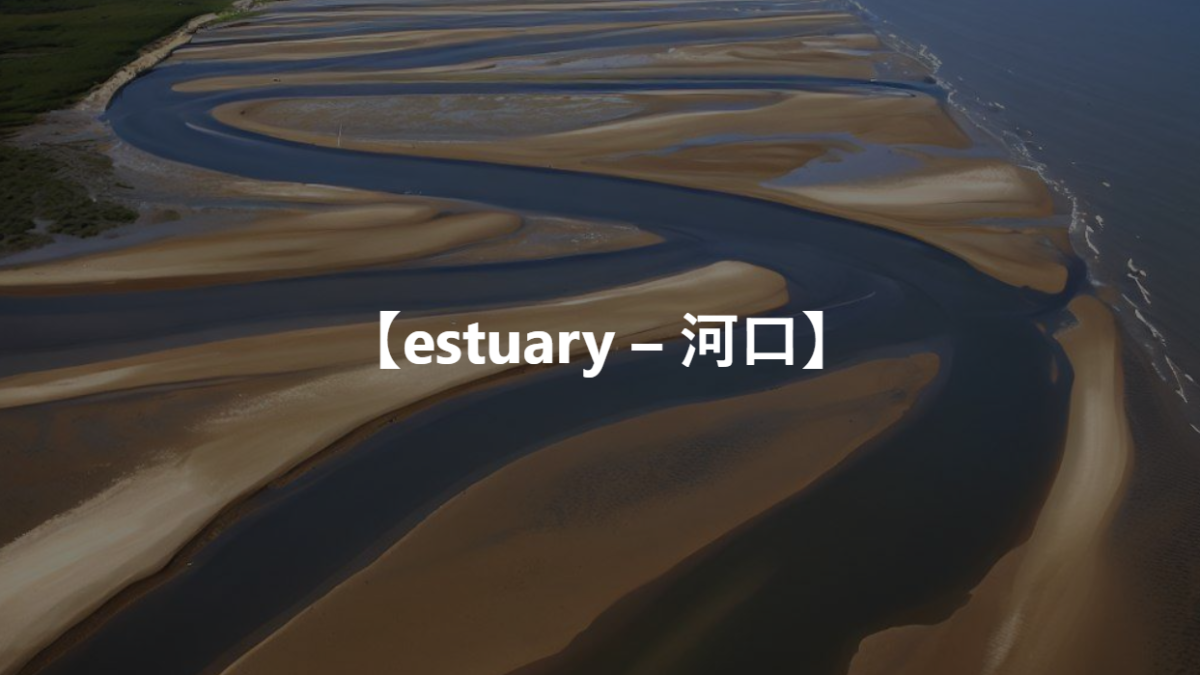語源・類義語・反対語・例文
【Estuary – 河口】という単語の語源とか由来を知っていますか?
「Estuary」は、ラテン語の「aestuarium」から来ており、これは「潮の満ち引き」や「潮汐湾」を意味します。この語はさらに、ラテン語の「aestus」に由来しており、「熱」や「潮の流れ」を意味し、潮の動きに関連した熱やエネルギーを表しています。このため、「estuary」という言葉は、河川が海に出会い、潮の満ち引きによって影響を受ける場所、つまり河口を指すのに用いられるようになりました。時間が経つにつれ、この言葉は河川と海が交わる地点、特に潮流の影響を強く受ける地域を指すために英語で広く使われるようになりました。
The word “estuary” originates from the Latin “aestuarium,” which means “tide” or “tidal bay.” This term further derives from the Latin “aestus,” meaning “heat” or “tide’s flow,” representing the heat or energy associated with the movement of tides. Consequently, the word “estuary” has come to be used to describe a place where a river meets the sea, influenced by the ebb and flow of tides. Over time, this term has been widely adopted in English to refer to the point where rivers and seas intersect, especially in areas strongly affected by tidal movements.
この単語の類義語・反対語を教えてください。
類義語
- Delta: 三角州。河口の一種で、河川が海に注ぐ際に形成される堆積物による土地。
- Mouth: (河川の)河口。河川が他の水域、特に海に流れ込む場所。
- Inlet: 入江。海や湖へと入る狭い水域、河口に似た自然の入り口。
- Fjord: フィヨルド。氷河によって形成された深く、狭い海の入り口。
- Cove: 小さな入江や湾。小規模ながら河口と似た特徴を持つことがある。
反対語
「Estuary」の反対語は直接的なものは少ないですが、以下のような単語が考えられます。
- Source: 源流。河川が始まる地点。
- Headwaters: 上流。河川の最も上流に位置する部分。
この単語を使った例文を5つほど教えてください。
The estuary of the river is teeming with diverse marine life.
(その川の河口は多様な海洋生物でいっぱいです。)
We took a boat tour to explore the beautiful estuary and its surrounding wetlands.
(美しい河口とその周辺の湿地を探検するために、ボートツアーに参加しました。)
The estuary serves as an important breeding ground for migratory birds.
(その河口は渡り鳥の重要な繁殖地となっています。)
The pollution in the estuary has had a negative impact on the local ecosystem.
(河口の汚染は地元の生態系に悪影響を与えています。)
Fishermen gather at the estuary to catch fish that migrate from the sea.
(漁師たちは河口で海から移動してくる魚を捕まえるために集まります。)
【estuary – 河口】のコロケーション
- tidal estuary: 潮汐河口。潮の満ち引きによって形成され、影響を受ける河口を指します。潮汐の動きが顕著な河口地域に使われます。
- estuary ecosystem: 河口生態系。河口地域に特有の生物とその生息環境を総称する言葉です。多様な生物種が共存する豊かな生態系を指します。
- estuary conservation: 河口の保全。河口地域の自然環境や生態系を保護し、維持するための活動や取り組みを意味します。
- estuary pollution: 河口汚染。河口地域が受ける汚染や環境破壊の状態を指します。工業廃水や生活排水などが原因で起こります。
- estuary wildlife: 河口の野生動物。河口地域に生息する動物たちを指します。特有の鳥類、魚類、その他多くの生物が含まれます。
「Estuary」、すなわち「河口」は、海と川が出会う場所を指す言葉です。この独特な地形は、様々な生物の生息地としての重要な役割を果たし、自然環境や生態系において特別な位置を占めています。ここでは、「estuary」がどのように使われるか、その一般的なコロケーションについて掘り下げてみましょう。
まず、tidal estuaryは、潮汐の影響を受ける河口を指し、この地域の環境がどのように日々変化するかを示します。次に、estuary ecosystemは、河口地域に特有の多様な生物とその生態系を表現するために用います。ここでは、魚類、鳥類、植物など、さまざまな種が共存しています。
estuary conservationは、これらの貴重な生態系を保護し、維持するための取り組みを意味します。人間の活動による影響からこれらの地域を守ることが重要です。一方、estuary pollutionは、河口が直面する環境汚染の問題を指摘し、解決が求められています。
最後に、estuary wildlifeは、河口地域に生息する野生動物を総称する言葉であり、この地域の生物多様性の豊かさを強調します。
“Estuary,” or the place where a river meets the sea, is a term that refers to a unique geographical feature. This distinct landscape plays a crucial role as a habitat for various species, holding a special position within natural environments and ecosystems. Let’s delve into how “estuary” is used and explore its common collocations.
First, tidal estuary refers to estuaries affected by tidal movements, illustrating how the environment in these areas changes daily. Next, estuary ecosystem is used to describe the diverse array of life and ecosystems unique to estuarine regions, where various species such as fish, birds, and plants coexist.
Estuary conservation signifies efforts to protect and maintain these valuable ecosystems. It’s crucial to safeguard these areas from the impacts of human activities. On the other hand, estuary pollution points out the environmental pollution issues estuaries face, highlighting the need for solutions.
Lastly, estuary wildlife collectively refers to the wild animals inhabiting estuarine areas, emphasizing the richness of biodiversity in these regions.
estuaryを使った英文法問題5問
1. 語彙問題
次のうち、estuaryの意味として最も適切なものはどれですか?
a. 湖 b. 川 c. 滝 d. 河口
解答と解説
d. 河口
estuaryは、川が海に流れ込む場所、つまり河口を意味する名詞です。
2. 空所補充
次の文の( )内に入る最も適切な単語はどれですか?
The ( ) is a rich ecosystem where freshwater and saltwater mix.
a. estuary b. river c. lake d. ocean
解答と解説
a. estuary
文脈から、淡水と海水が混ざり合う豊かな生態系は河口であるため、estuaryが適切です。
3. 冠詞の選択
次の文の( )内に入る適切な冠詞はどれですか?
The city is located near ( ) estuary of the Thames River.
a. a b. an c. the d. 無冠詞
解答と解説
c. the
特定の河口(テムズ川の河口)を指しているため、定冠詞のtheが適切です。
4. 単数形か複数形か
次の文の( )内に入る適切なestuaryの形はどれですか?
Many birds migrate to ( ) in the winter.
a. estuary b. estuarys c. estuaries d. an estuary
解答と解説
c. estuaries
文脈から、複数の河口を指しているため、複数形のestuariesが適切です。
5. 文法的な誤りの指摘
次の文には文法的な誤りが1箇所あります。その誤りを含む部分を指摘し、正しい形に直してください。
The mangrove forests in the estuary provides a habitat for various species of fish.
解答と解説
誤り: provides 正しい形: provide
主語がmangrove forests(複数形)であるため、動詞も複数形のprovideが適切です。

